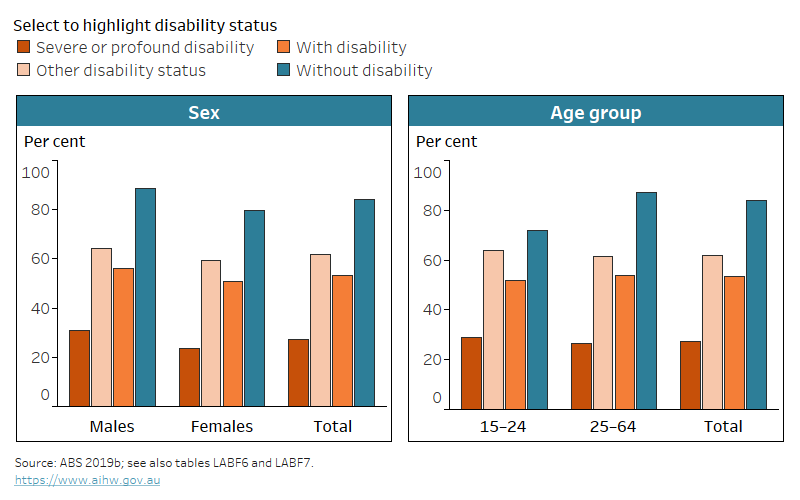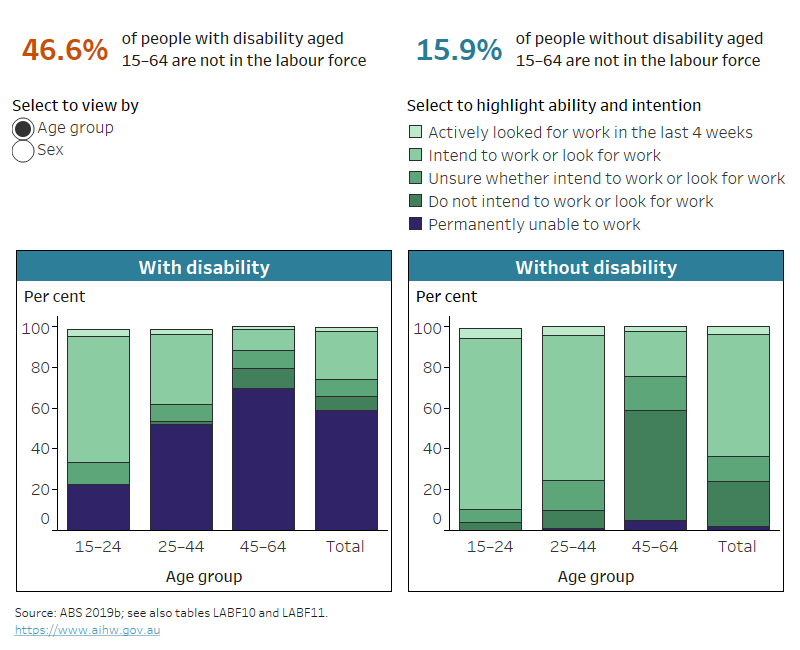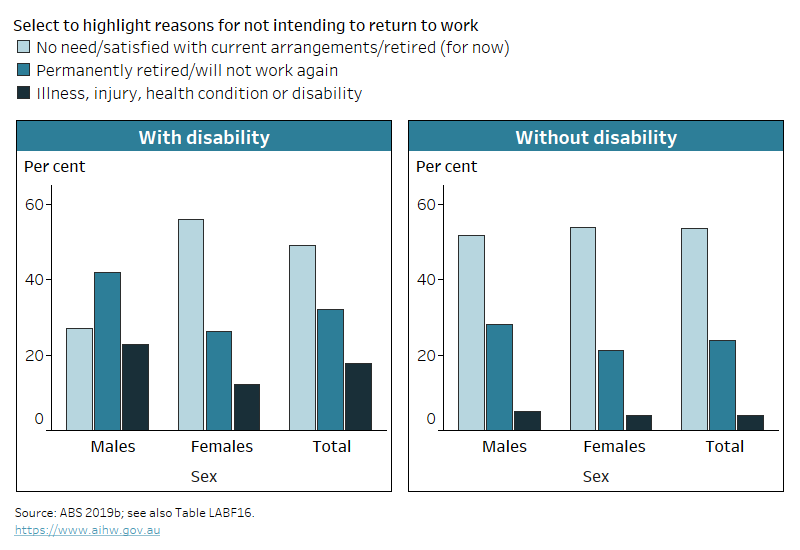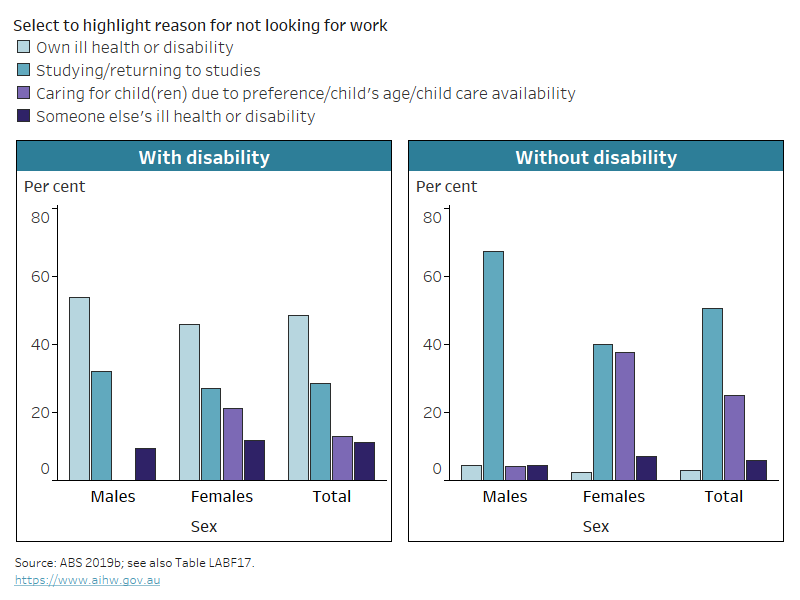Labour force participation
Labour force participation
In 2018, 53% of people aged 15–64 with disability were in the labour force, compared with 84% of those without disability.
People with severe or profound disability
In 2018, 27% of people aged 15–64 with severe or profound disability were in the labour force, compared with 62% with other disability status.
Permanently unable to work
In 2018, 59% of people aged 15–64 with disability who were not in the labour force were permanently unable to work.
On this page:
Introduction
More than 1 million people aged 15–64 with disability are working or looking for work (are in the labour force). This has remained stable over 15 years – 53% of people aged 15–64 with disability participated in the labour force in 2018 (or 1.1 million) and 2003 (or 1.2 million) (ABS 2019b, ABS 2004). Among those with severe or profound disability 27% were in the labour force in 2018 and 30% in 2003 (ABS 2019b, ABS 2004).
How is labour force participation defined?
People who are in the labour force include those aged 15 and over who are employed or unemployed. In previous versions of this report, people aged 15–64 were referred to as ‘working-age’. The term ‘working-age’ is no longer used in this report, but the results presented are in most cases still limited to people aged 15–64 for consistency with previous versions.
In the labour force:
- people who are employed include those who reported that they had worked in a job, business, or on a farm during the reference week (the full week before the date of their survey interview); or had a job in the reference week, but were not at work
- people who are unemployed include those who reported that they were not employed during the reference week, and had actively looked for full- or part-time work at any time in the 4 weeks up to the end of the reference week and were available for work in the reference week.
Not in the labour force:
- people who are not employed and are not unemployed. This includes people who undertake only unpaid household duties or other voluntary work, those who are retired, voluntarily inactive and those permanently unable to work (ABS 2022).
Data note
Data on this page are largely sourced from the Australian Bureau of Statistics (ABS) 2018 Survey of Disability, Ageing and Carers (SDAC). For more information about the SDAC, including the concepts of disability, disability severity, disability groups, and remoteness categories used by the SDAC, see ‘Data sources’.
Unless otherwise indicated, all data on this page refer to 2018.
People aged 65 and over
Most (88% or 1.1 million in 2018) people with disability who participate in the labour force are aged 15–64. The rest are aged 65 and over (159,000) (ABS 2019b).
With increasing life expectancies and improvements in health care, today's Australians are generally living longer and healthier lives than those in previous generations (AIHW 2023). The eligibility age for the Age Pension has also increased in recent years. For some older people, including those with disability, these factors may mean staying longer in the workforce.
Labour force participation rate
People with disability have a lower labour force participation rate than people without disability. Just over half (53% or 1.1 million) of people aged 15–64 with disability are in the labour force, compared with 84% (or 11.8 million) without disability. This is particularly so for those with severe or profound disability (27% or 137,000 compared with 62% or 960,000 with other disability status) (ABS 2019b).
Labour force participation rate
The labour force participation rate is the number of people who are employed or unemployed expressed as a percentage of the population aged 15 and over. The results presented in this report are mostly limited to people aged 15–64.
Generally, males are more likely to be in the labour force than females (Figure LABOUR.1). This is true for people with and without disability:
- 56% (or 563,000) of males aged 15–64 with disability are in the labour force, compared with 51% (or 535,000) of females
- 89% (or 6.2 million) of males aged 15–64 without disability, compared with 80% (or 5.6 million).
Similarly, for those with severe or profound disability, 31% (or 76,000) of males with disability are in the labour force compared with 24% (or 61,000) of females (ABS 2019b).
People aged 15–64 with sensory and speech disability (55% or 225,000) and physical disability (49% or 632,000) are more likely to be in the labour force than those with head injury, stroke or acquired brain injury (32% or 51,000) and psychosocial disability (33% or 215,000) (ABS 2019b).
Figure LABOUR.1: Labour force participation rate for people aged 15–64, by disability status and severity, sex and age group, 2018
The chart shows people aged 25–64 with disability are less likely (54%) to participate in the labour force than those without disability (87%).

Notes:
- Restricted to people aged 15–64 living in households.
- The labour force includes people who are employed or unemployed.
- Figures are rounded and underwent ABS confidentiality and perturbation processes.
Source data tables: Data tables – Labour force participation. View data tables
Labour force participation of young people with disability
Young people (aged 15–24) with disability are about as likely to be in the labour force (52% or 152,000) as people with disability aged 25–64 (54% or 948,000). However, young people with disability are less likely to be in the labour force than their peers without disability (72% or 2.0 million in the labour force). This is especially true for young people with severe or profound disability (29% or 31,000 in the labour force), compared with 64% (or 119,000) of those with other disability status (ABS 2019b).
Young people with disability who are in the labour force are:
- more likely to be unemployed (25% or 38,000) than those without disability (11% or 233,000)
- less likely to be employed full time (24% or 36,000) than those without disability (36% or 735,000) (ABS 2019b).
Note: Full-time employment is working 35 hours per week or more (in all jobs) (ABS 2019a).
Reasons for not being in the labour force
Close to half (47% or 959,000) of all people aged 15–64 with disability are not in the labour force. Of these:
- most (59% or 562,000) are permanently unable to work
- almost a quarter (23% or 224,000) intend to work or look for work
- 1 in 12 (8.7% or 83,000) are unsure if they intend to work or look for work
- 1 in 15 (6.9% or 67,000) do not intend to work or look for work (Figure LABOUR.2).
This varies by age and sex (Figure LABOUR.2):
- Proportion of people permanently unable to work increases with age, from 22% (or 32,000) of people with disability not in the labour force aged 15–24, to 52% (or 112,000) of those aged 25–44, and 69% (or 418,000) of those aged 45–64.
- Proportion of people with disability not in the labour force who intend to work or look for work falls with age, from 62% (or 88,000) of people aged 15–24, to 34% (or 74,000) of those aged 25–44, and 10% (or 62,000) of those aged 45–64. The same pattern is observed for people without disability.
- Males with disability not in the labour force are more likely than females to be permanently unable to work – 64% (or 282,000) compared with 54% (or 279,000).
- Females with disability not in the labour force are more likely to not intend to work or look for work than males – 9.0% (or 47,000) compared with 4.6% (or 20,000) (Figure LABOUR.2, ABS 2019b).
Figure LABOUR.2: Ability and intention to work and look for work, for people who are not in the labour force, by disability status, age group and sex, 2018
The chart shows people aged 25–44 with disability are less likely (34%) to intend to work or look for work than those without disability (71%).

Notes:
* Relative standard error of 25–50% and should be used with caution.
- Restricted to people aged 15–64 living in households who are not in the labour force.
- People who intend to, are unsure whether intend to, or do not intend to work are limited to those who are not in the labour force, not permanently unable to work, and have not looked for work in the last 4 weeks.
- The category ‘Do not intend to work or look for work’ for people aged 15–24 with disability has a relative standard error greater than 50% and is considered too unreliable for general use. The category ‘Permanently unable to work’ has not been recorded for any people aged 15–24 without disability. Therefore, these categories are not shown in this figure for those populations.
- Figures are rounded and underwent ABS confidentiality and perturbation processes.
Source data tables: Data tables – Labour force participation. View data tables
People aged 15–64 with disability who are not in the labour force are far more likely than those without disability to be permanently unable to work (59% or 562,000 compared with 2.1% or 48,000). They are also much less likely to intend to work or look for work (23% or 224,000 compared with 60% or 1.3 million) (Figure LABOUR.2, ABS 2019b).
About two-thirds (67% or 64,000) of people aged 15–64 with disability who are not in the labour force and live in Outer regional and remote areas are permanently unable to work compared with those living in Major cities (54% or 329,000) (ABS 2019b).
People who are permanently unable to work
Of people aged 15–64 with disability who are permanently unable to work:
- 9 in 10 (91% or 511,000) said it was because of their own condition or disability
- 1 in 7 (12% or 70,000) said it was because of someone else's ill health or disability (people could give more than one reason) (ABS 2019b).
When asked about requirements to enable workforce participation, 96% said they could not work at all. Some reported they may be able to participate if certain requirements were met, such as training, equipment and assistance with work or personal care tasks (2.8% or 16,000) (ABS 2019b).
People able to work
People able to work refers to people aged 15–64 not permanently unable to work.
People who do not intend to work or look for work
For people aged 15–64 with disability able to work but not intending to work or look for work, the most common reasons for this were (more than one reason could be given):
- half (49% or 33,000) have no need to work, are satisfied with current arrangements or are retired (for now)
- 32% (or 21,000) are permanently retired or will not work again
- 18% (or 12,000) cited their short-term illness or injury or long-term health condition or disability (Figure LABOUR.3).
Males with disability able but not intending to work (42% or 9,000) are much more likely than their female counterparts (26% or 12,000) to report they are permanently retired or will not work again. Females with disability able but not intending to work (56% or 26,000) are more likely than their male counterparts (27% or 6,000) to report that they have no need to work, are satisfied with current arrangements or are retired (for now) (ABS 2019b).
Figure LABOUR.3: Reasons for not looking for work in the last 4 weeks for people who are not in the labour force, not permanently unable to work and do not intend to work, by disability status and sex, 2018
The chart shows males with disability are more likely (42%) to be retired or state they will not work again than those without disability (28%).

Notes:
* Relative standard error of 25–50% and should be used with caution.
- Restricted to people aged 15–64 living in households who are not in the labour force, not permanently unable to work, have not actively looked for work in last 4 weeks and do not intend to work or look for work.
- Reasons not shown in the figure are studying/returning to studies, home duties or caring for child(ren), welfare payments/pension/allowance may be affected, moving house, taking holidays, caring for ill/disabled/elderly person(s), pregnancy, and other reason.
- More than one reason for not intending to work or look for work may be reported.
- Figures are rounded and underwent ABS confidentiality and perturbation processes.
Source data tables: Data tables – Labour force participation. View data tables
People who may work in the future
People who may work in the future are those who:
- have not looked for work but intend to work or look for work
- are not sure if they will work.
For those with disability aged 15–64 the most common reasons for not looking for work in the last 4 weeks were (more than one reason could be reported):
- own ill health or disability (49% or 145,000)
- studying or returning to study (28% or 85,000)
- children too young or prefer to look after them and child care availability (13% or 39,000)
- someone else’s ill health or disability (11% or 33,000) (Figure LABOUR.4).
Differences in reasons between males and females with disability who may work in the future are similar to those for people who do not intend to work or look for work. For example, of people aged 15–64 with disability who may work in the future (Figure LABOUR.4):
- males are more likely than females to give their own ill health or disability as a reason for not looking for work – 54% (or 67,000) compared with 46% (or 81,000)
- 32% (or 40,000) of males report studying or returning to studies as a reason as do 27% (or 47,000) of females
- females are likely to cite family or relationship considerations as reasons for not looking for work
- children being too young or preferring to look after them and child care availability – 21% (or 37,000) of females
- someone else’s ill health or disability – 12% (or 21,000)
- other family considerations – 9.7% (or 17,000) (ABS 2019b).
Figure LABOUR.4: Reasons for not looking for work in the last 4 weeks for people who are not in the labour force, not permanently unable to work and may work in the future, by disability status and sex, 2018
The chart shows females without disability are more likely (38%) to not look for work due to caring for children than those with disability (21%).

Notes:
- Restricted to people aged 15–64 living in households who are not in the labour force, not permanently unable to work, and have not looked for work in the last 4 weeks but intend to work or look for work in the future, or are unsure.
- Reasons not shown in the figure are retired/too old/do not need or want to work, other family considerations, pension or welfare payments might be affected, pregnancy, lacks relevant schooling, training or experience, other and don’t know.
- More than one reason for not intending to work or look for work may be reported.
- No males with disability were recorded as not looking for work due to caring for child(ren).
- Figures are rounded and underwent ABS confidentiality and perturbation processes.
Source data tables: Data tables – Labour force participation. View data tables
ABS (2004) Disability, Ageing and Carers, Australia: Summary of Findings, 2003, ABS, accessed 27 October 2023.
ABS (2019a) Disability, Ageing and Carers, Australia: Summary of Findings methodology, 2018, ABS, accessed 30 August 2023.
ABS (2019b) Microdata: disability, ageing and carers, Australia, 2018, ABS cat. No. 4430.0.30.002, AIHW analysis of TableBuilder data, accessed 3 August 2021.
ABS (2022) Labour statistics: concepts, sources and methods, 2021, ABS, accessed 30 August 2023.
AIHW (Australian Institute of Health and Welfare) (2023) Older Australians, cat. No. AGE 87, AIHW, accessed 25 September 2023.


